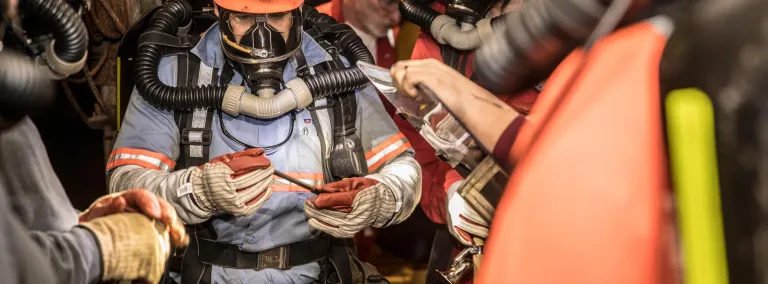Emergency response team is ready for anything
Members of ERT train regularly to ensure they are ready for any emergency—on the surface or underground
About 4,000 feet southwest of the Yates Shaft, several members of Sanford Lab’s Emergency Response Team (ERT) stepped into a secondary egress drift on the 4100 Level. In full gear, including breathing apparatus, they carefully walked—and at times crawled—through the narrow, timber-lined tunnel. It was all part of the training regimen that keeps the ERT ready to respond at a moment’s notice to any emergency.
“We have a multi-disciplined team and we want to make sure they can respond to multiple scenarios,” said Tom Regan, acting ERT Lead and safety consultant to Sanford Lab. “That means they need to train regularly, especially in areas that support our ventilation systems, so they can be ready for any emergency.”
">
An emergency is defined as any serious situation or occurrence that happens unexpectedly, poses an immediate risk to life, health, property or the environment, and that demands immediate action. The ERT is our first line of defense and has to be able to respond accordingly—for both surface and underground emergencies.
Prospective members must meet certain physical requirements. They undergo on-site orientation and general safety basic classes followed by a 20-hour introductory course. They train in surface and underground incidents and are required to understand how to use and maintain emergency response equipment, including the breathing apparatus. Once on the team, they participate in monthly and quarterly exercises—everything from medical emergencies and first aid to emergency notification to surface and underground evacuations drills.
Team members also work with and can provide assistance for communities throughout the Lawrence County Emergency management and work closely with the South Dakota School of Mines and Technology in the training of its mine rescue team.
“We want the SURF emergency response team to be a world-class team,” said Larry Jaudon, Sanford Lab’s Environment, Safety and Health director. “Our team members are dedicated and work hard to meet the highest standards.”
To ensure they meet those high industry standards, the team follows best practices set by OSHA (Occupational Safety and Health Administration) and MSHA (Mine Safety and Health Administration). Last week’s training focused on using the self-contained breathing apparatus.
“When we do an exercise like this, we’re trying to simulate an actual event, so we behave as if this was a real emergency,” Regan said. “We did the exercise under oxygen—from the cage ride all the way down to the 4100 Level then through the drift and back to our base.” In all, the team was under oxygen for more than two hours.
Team members also assist with the development and enhancement of emergency response plans and participate in annual level inspections.
“You know, there are miles and miles of tunnels above the 4850 Level that have to be inspected,” said Regan, who worked with Homestake Mine for over 40 years and has been with Sanford Lab since 2007. The team physically inspects safety systems (air doors and walls), ground conditions and water drainage systems.
“We want to make sure there are no potential risks to safe passage or the core infrastructure of the facility, so scientists and others can do their work safely,” Regan said.
